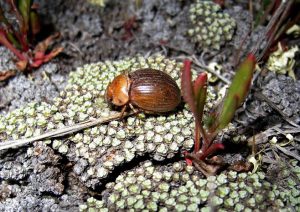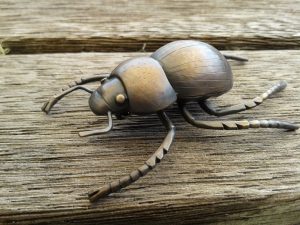Prodontria lewisii
Critically endangered, this small, flightless, unremarkable, brown beetle has a habitat of 81 hectares in the arid Cromwell basin of Central Otago. It was never a habitat larger than 500 hectares, and the construction of the Clyde Dam and resulting Lake Dunstan combined with land repurposed for housing development and a golf course has eaten up more than 80% of their original habitat.
The remaining habitat is under threat from the ravages of the Australian Redback spider, an unwanted import who makes it’s home in the abandoned rabbit burrows that litter the sandy loam the chafer beetle lives in. The Redbacks build a web in the empty holes, and repurpose them as a nursery for baby red-back spiders. Apparently one enterprising Redback had preyed upon 70 chafer beetles, as evidenced by the midden of crispy beetle husks piled in his lair. Chafer beetles are the second favourite prey of the Redback, after the darkling beetle.
Department of Conservation staff have been gingerly removing Redbacks from the former burrows with long-handled tongs, and then infilling the holes. This seems to be an effective solution for dealing with the spider problem.
Every December a chafer beetle larvae count is carried out by DoC staff, under the brutal Central Otago sun. More than 600 soil cores are removed from the earth, and hand-sifted through by the participants, in the hope of finding the elusive little grubs. The numbers found are generally very low, maybe just a few individuals. The beetle population is estimated to be about 3000. Cromwell chafer beetle larvae spend many months buried in the sand chewing through tussock roots. They go through three phases of instar before pupating for three months. When the adult beetle finally metamorphoses, it spends it’s days burrowed up to half a metre underground, before emerging on spring and summer evenings to mate, and feast on scabweed.
I don’t know if the Cromwell chafer beetle will survive all the threats it faces. It’s difficult to feel hopeful.
Silver brooch


